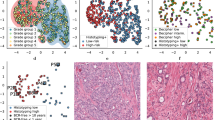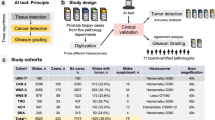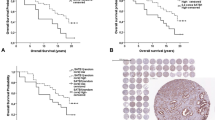Abstract
Active surveillance provides a unique opportunity to study biomarkers of prostate cancer behaviour, although only small volumes of tumor tissue are typically available. We have evaluated a technique for constructing tissue microarrays (TMAs) from needle biopsies for assessing immunohistochemical markers in localized prostate cancer managed by active surveillance. TMAs were constructed from diagnostic prostate biopsies for 60 patients with localized prostatic adenocarcinoma in a prospective cohort study of active surveillance. Radical treatment was recommended for a prostate-specific antigen (PSA) velocity greater than 1 ng ml−1 per year or adverse histology in repeat biopsies, defined as Gleason score ⩾4+3 or >50% of cores involved. Sections from the TMAs were stained with H&E, P63/AMACR and Ki-67. Time to radical treatment was analysed with respect to clinical characteristics and Ki-67 LI. At a median follow up of 36 months, 25/60 (42%) patients had received radical treatment. On univariate analysis, PSA density (P=0.001), Gleason score (P=0.001), clinical T stage (P=0.01), Ki-67 LI (P=0.02) and initial PSA (P=0.04) were associated with time to radical treatment. On multivariate analysis, PSA density (P=0.01), Ki-67 LI (P=0.03) and Gleason score (P=0.04) were independent determinants of progression to radical treatment. TMAs constructed from prostate needle biopsies can be used to assess immunohistochemical markers in localized prostate cancer managed by active surveillance. Ki-67 LI merits further study as a possible biomarker of early prostate cancer behaviour.
This is a preview of subscription content, access via your institution
Access options
Subscribe to this journal
Receive 4 print issues and online access
$259.00 per year
only $64.75 per issue
Buy this article
- Purchase on Springer Link
- Instant access to full article PDF
Prices may be subject to local taxes which are calculated during checkout



Similar content being viewed by others
References
Bill-Axelson A, Holmberg L, Ruutu M, Haggman M, Andersson SO, Bratell S et al. Radical prostatectomy versus watchful waiting in early prostate cancer. N Engl J Med 2005; 352: 1977–1984.
Albertsen P, Gleason D, Barry M . Competing risk analysis of men aged 55–74 years at diagnosis managed conservatively for clinically localized prostate cancer. JAMA 1998; 280: 975–980.
Choo R, Klotz L, Danjoux C, Morton GC, DeBoer G, Szumacher E et al. Feasibility study: watchful waiting for localized low to intermediate grade prostate carcinoma with selective delayed intervention based on prostate specific antigen, histological and/or clinical progression. J Urol 2002; 167: 1664–1669.
Klotz LH, Choo R, Morton G, Danjoux C . Expectant management with selective delayed intervention for favorable-risk prostate cancer. Can J Urol 2002; 9 (Suppl 1): 2–7.
Parker CC . Re: long-term efficacy of zoledronic acid for the prevention of skeletal complications in patients with metastatic hormone-refractory prostate cancer. J Natl Cancer Inst 2004; 96: 1480; author reply 1480–1481.
Martin RM, Gunnell D, Hamdy F, Neal D, Lane A, Donovan J . Continuing controversy over monitoring men with localized prostate cancer: a systematic review of programs in the prostate specific antigen era. J Urol 2006; 176: 439–449.
Singh SS, Mehedint DC, Ford III OH, Maygarden SJ, Ruiz B, Mohler JL . Feasibility of constructing tissue microarrays from diagnostic prostate biopsies. Prostate 2007; 67: 1011–1018.
Jhavar S, Corbishley CM, Dearnaley D, Fisher C, Falconer A, Parker C et al. Construction of tissue microarrays from prostate needle biopsy specimens. Br J Cancer 2005; 93: 478–482.
Cher ML, Chew K, Rosenau W, Carroll PR . Cellular proliferation in prostatic adenocarcinoma as assessed by bromodeoxyuridine uptake and Ki-67 and PCNA expression. Prostate 1995; 26: 87–93.
Gerdes J . Ki-67 and other proliferation markers useful for immunohistological diagnostic and prognostic evaluations in human malignancies. Semin Cancer Biol 1990; 1: 199–206.
Bettencourt MC, Bauer JJ, Sesterhenn IA, Mostofi FK, McLeod DG, Moul JW . Ki-67 expression is a prognostic marker of prostate cancer recurrence after radical prostatectomy. J Urol 1996; 156: 1064–1068.
Bubendorf L, Sauter G, Moch H, Schmid HP, Gasser TC, Jordan P et al. Ki67 labelling index: an independent predictor of progression in prostate cancer treated by radical prostatectomy. J Pathol 1996; 178: 437–441.
Coetzee LJ, Layfield LJ, Hars V, Paulson DF . Proliferative index determination in prostatic carcinoma tissue: is there any additional prognostic value greater than that of Gleason score, ploidy and pathological stage? J Urol 1997; 157: 214–218.
Cowen D, Troncoso P, Khoo VS, Zagars GK, von Eschenbach AC, Meistrich ML et al. Ki-67 staining is an independent correlate of biochemical failure in prostate cancer treated with radiotherapy. Clin Cancer Res 2002; 8: 1148–1154.
Harper ME, Goddard L, Wilson DW, Matanhelia SS, Conn IG, Peeling WB et al. Pathological and clinical associations of Ki-67 defined growth fractions in human prostatic carcinoma. Prostate 1992; 21: 75–84.
Mashal RD, Lester S, Corless C, Richie JP, Chandra R, Propert KJ et al. Expression of cell cycle-regulated proteins in prostate cancer. Cancer Res 1996; 56: 4159–4163.
McLoughlin J, Foster CS, Price P, Williams G, Abel PD . Evaluation of Ki-67 monoclonal antibody as prognostic indicator for prostatic carcinoma. Br J Urol 1993; 72: 92–97.
Pollack A, DeSilvio M, Khor LY, Li R, Al-Saleem TI, Hammond ME et al. Ki-67 staining is a strong predictor of distant metastasis and mortality for men with prostate cancer treated with radiotherapy plus androgen deprivation: Radiation Therapy Oncology Group Trial 92-02. J Clin Oncol 2004; 22: 2133–2140.
Borre M, Stausbol-Gron B, Nerstrom B, Overgaard J . Immunohistochemical BCL-2 and Ki-67 expression predict survival in prostate cancer patients followed expectantly. Prostate Cancer Prostatic Dis 1998; 1: 268–275.
Stattin P, Damber JE, Karlberg L, Bergh A . Cell proliferation assessed by Ki-67 immunoreactivity on formalin fixed tissues is a predictive factor for survival in prostate cancer. J Urol 1997; 157: 219–222.
Bubendorf L, Tapia C, Gasser TC, Casella R, Grunder B, Moch H et al. Ki67 labeling index in core needle biopsies independently predicts tumor-specific survival in prostate cancer. Hum Pathol 1998; 29: 949–954.
Borre M, Bentzen SM, Nerstrom B, Overgaard J . Tumor cell proliferation and survival in patients with prostate cancer followed expectantly. J Urol 1998; 159: 1609–1614.
Acknowledgements
This work was undertaken in The Royal Marsden NHS Foundation Trust who received a proportion of its funding from the NHS Executive; the views expressed in this publication are those of the authors and not necessarily those of the NHS Executive. This work was supported by the Institute of Cancer Research, the Cancer Research UK Section of Radiotherapy (CUK) grant number C46/A2131 and NCRI South of England Prostate Cancer Collaborative.
Author information
Authors and Affiliations
Corresponding author
Rights and permissions
About this article
Cite this article
Jhavar, S., Bartlett, J., Kovacs, G. et al. Biopsy tissue microarray study of Ki-67 expression in untreated, localized prostate cancer managed by active surveillance. Prostate Cancer Prostatic Dis 12, 143–147 (2009). https://doi.org/10.1038/pcan.2008.47
Received:
Revised:
Accepted:
Published:
Issue Date:
DOI: https://doi.org/10.1038/pcan.2008.47
Keywords
This article is cited by
-
Incorporation of tissue-based genomic biomarkers into localized prostate cancer clinics
BMC Medicine (2016)
-
Prostatakarzinom
Der Pathologe (2016)
-
Comparison of digital image analysis and visual scoring of KI-67 in prostate cancer prognosis after prostatectomy
Diagnostic Pathology (2015)
-
Prognostic value of Ki-67 for prostate cancer death in a conservatively managed cohort
British Journal of Cancer (2013)
-
Serum micronutrient and antioxidant levels at baseline and the natural history of men with localised prostate cancer on active surveillance
Tumor Biology (2010)



